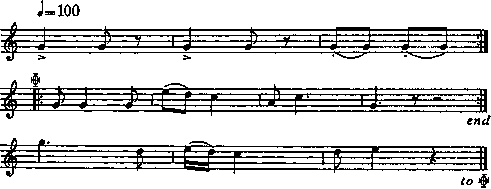Folk & Traditional Music of the Western Continents
The folk & traditional music of Europe, Africa & the Americas explored.
| Share page | Visit Us On FB |
|
18 STUDYING THE STRUCTURE OF FOLK MUSIC |
||
|
|
||
|
analyzed with the following letters: A1A2BA2. Sometimes the interrelationship is more complex, as in Example 2-2 where a section reappears at clifferent pitch levels.
Example 2-2 could be analyzed by the letters AA15A25A, A5 being a transposition, a perfect fifth higher, of A. Forms such as AABB, ABBA, and ABCA appear frequently in European folk music. In the music of some non-Western cultures, songs don't have a clearly marked ending. Some American Indian songs consist simply of a loose, informal alternation of two different phrases or sections of music. These can also be analyzed in terms of letters, as indicated here. The following Navaho Indian song (Example 2-3) consists essentially of two sections, A and B which appear in the following order: AABAAAB, and so forth. |
||
|
|
||
 |
||
|
|
||
|
example 2-3. Navaho Indian song, from Bruno Ncttl, North American Indian Musical Styles (Philadelphia: Memoir 45 of the American Folklore Society, 1954), p. 47. |
||
|
|
||
|
Listening to a sampling of records will soon convince the student that the various folk musics of the world don't have too much in common. To be sure, neighboring tribes and nations exhibit similarities, presumably because there has been contact between them for centuries. But among the more distant regions of the world there is vigorous contrast. Practically anything that could legitimately be considered music exists somewhere in the world's traditional" cultures. Perhaps the only limitation is imposed by the need for transmitting the material orally (or aurally) without the use of notation. This makes necessary a certain degree of simplicity; and where some complexity exists, there is a need for certain unifying factors in the |
||